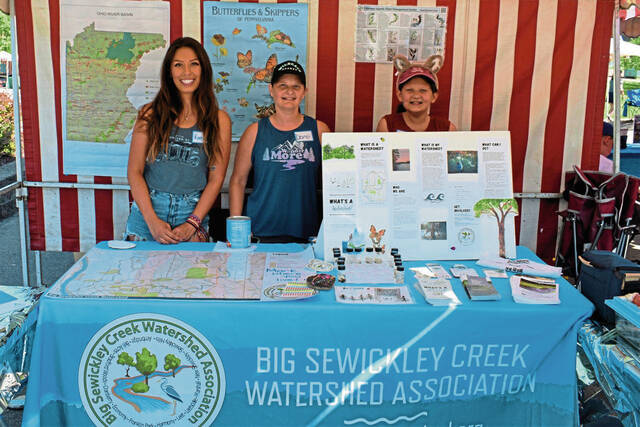https://development.triblive.com/local/sewickley/big-sewickley-creek-watershed-group-using-mini-grants-to-shine-light-on-conservation-efforts/
Big Sewickley Creek Watershed group using mini grants to shine light on conservation efforts

For the past two years, a group of residents has been monitoring the work of natural gas drillers operating in the Big Sewickley Creek Watershed to make sure they are following the rules to prevent polluting or damaging the waterway’s delicate ecosystem.
But their conservation efforts go beyond just looking over the shoulders of drilling operators.
Formed in August 2020, the Big Sewickley Creek Watershed Association has been involved in projects such as stream assessments, litter cleanups and other conservation efforts in the 30-square-mile watershed covering parts of 12 municipalities in three counties.
But informing the public about its activities has been no simple task for the burgeoning organization, which relies on donations from local businesses and the public along with grants from environmental organizations such as the Western Pennsylvania Conservancy.
To help spread the word about its efforts, the organization will use a grant from the conservancy for promotional materials.
While local news outlets have covered the watershed association’s efforts to hold drillers accountable, the group has not had the means to promote other activities beyond using “free” media such as Facebook.
“We are a small grass-roots organization,” said Katie Stanley, president of the watershed association. “Without this generous grant, we would not be able to launch our website and obtain supplies to continue doing events like litter cleanups, which is really the main reason why we started.”
Stanley said while circumstances have resulted in the organization getting involved in the larger issue of monitoring how fracking operations impact the waterway, the association was launched as a community group.
“We really want to focus on education and be a voice for Big Sewickley Creek and find ways for people to get involved, so this grant helps us do that,” she said.
Future projects the Association is contemplating include stream bed restoration, planting to prevent erosion and creating a forum for the 12 communities in the watershed to communicate and share ideas and concerns.
But the need to get boots on the ground regularly to keep debris out of the waterway can’t be overstressed, Stanley said.
“Litter is such a common issue in our watershed, and this grant makes it possible for us to strengthen our outreach to the community and make a real impact on the health of our waterways,” she said. “These funds will allow the BSCWA to become a more recognized asset in the communities within the watershed and obtain marketing and stream cleanup materials.”
The $1,963 grant was provided by BHE GT&S, a natural gas drilling company based in Richmond, Va., and was administered through the annual mini-grant program offered by the Western Pennsylvania Conservancy.
The informational material will be available in time for the organization’s next litter cleanup scheduled for Saturday, Nov. 5, from 10 a.m. to noon along Cooney Hollow Road in Economy Borough.
This year, the Conservancy gave out 20 grants totaling $41,000.
Kelly Horrell, who coordinates the grant process for the Conservancy said even though the amounts awarded are small, they serve a role that would otherwise go unmet.
“They really help these organizations a lot because most of the larger grants don’t allow the money to be spent on certain things, like the information material that is handed out at events,” she said.
The Conservancy’s mini-grants can be used to buy water quality testing equipment, materials for stream restoration projects and for outreach and promotion.
“Money for those kind of things is hard to come by,” she said. “So we’re happy to be able to fund some of these needs.”
Since its formation, the organization’s efforts have focused on providing independent oversight of drilling operators.
In July 2021, the group raised objections over PennEnergy Resources’ plan to draw as much as 3 million gallons of water a day from the creek and one of its tributaries for natural gas drilling.
The water is used for hydraulic fracturing, or “fracking,” a technique used to extract oil and gas from bedrock by injecting a high-pressure mixture of water, sand or gravel and chemicals.
In October 2021, the state Department of Environmental Resources rejected PennEnergy Resources’ application.
In April, PennEnergy submitted a new application to draw water from the creek that also is being opposed by the organization.
Stanley said the permit has not yet been issued to PennEnergy Resources.
“There’s still a lot of back and forth between us and the state regarding this application,” she said. “It’s not a done deal. And it remains a big issue for us. Our concern is that if this is approved, other companies will see Big Sewickley Creek as the go-to place to get water for fracking. So we are staying on top of this.”
One of the chief concerns raised about drawing large amounts of water from the creek is how it will impact aquatic life and the stream bed if the level drops even more during a summer drought.
Big Sewickley Creek and its tributaries support a stocked trout population and are home to the Southern Redbelly Dace, which is a threatened species in Pennsylvania, according to a biologist for the state Fish and Boat Commission.
Earlier this year, the Watershed Association also launched an effort to get the state to require another company, Energy Transfer, to restore damage to the stream it caused instead of buying so-called “restoration credits” that would allow the company to do repairs in a different location.
Stanley said efforts to change that practice will have to occur at the state level, either through legislative or administrative action.
Copyright ©2025— Trib Total Media, LLC (TribLIVE.com)
